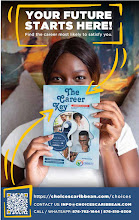
by Angela deFreitas
Do you remember when a portfolio was something which art school graduates proudly lugged around and as they glowingly showed off the best of their creative works produced during their course of study?
Well, times have changed and now a specific “career portfolio” is seen and recognised as an essential tool for any job seeker, not just those heading for the art world.
Savvy job-seekers think of a career portfolio as their very own portable collection of papers, documents and essential job and education-related tools and/or artifacts presented in a variety of formats.
A career portfolio can also be considered as part of your self-marketing arsenal, an extension of your resume and cover letter and something which you can take with you to an interview as proof of your achievements
A career portfolio will bring life and interest to an interview and may just give you the edge or another candidate. As you build a career portfolio you will realize that you are understanding and knowing yourself much better and you will thus be able to answer interview questions much more confidently as you have brought together information about yourself, your aspirations, interests and your experiences. To a question such as “what past experience do you have which would make you best suited to this position?”, you will not only have an answer but in some cases you will have proof as you will be able to pull this out from your portfolio.
Now that you know just how important such a tool is here’s a heads up on what it’s all about.
It is a fact that whether you are 14, 24 or 34 a career portfolio is the way to go. If you do not already have a career portfolio, you can create one now. Your portfolio will include:
1. Results of assessment tests you have done – like The Career Key (Caribbean Edition).
2. A copy of your resume. This should be kept up-to-date at all times by adding all new work experience, training programmes attended and qualifications as they occur.
3. A basic cover letter which you MUST update and modify to suit each job application.
3. Information you learn about promising occupations. You can scan newspapers, magazines and the internet for this type of information. Look out for stories on companies where you would like to work and add those also.
4. A brief statement written by you outlining your career plans and goals, and steps you will take towards achieving those goals.
5. Include copies of your external exam certificates. You will need these at job interviews as proof of your qualifications.
6. Certificates of achievement from school and extra-curricular activities and previous jobs. Photographs can be included also.
7. Records of things you have done and feel good about. These will be a good reminder and may be included in your resume or when answering interview questions.
8. Information about schools and colleges, training programmes and college courses. You must always be looking for ways to improve your qualifications and skills.
9. Add internet job search sites and also the names and contact details of reputable employment agencies.
10. Letter of appreciation, commendation or any recommendation received at previous jobs or for community service.
11. Newspaper, magazine or newsletter clippings featuring you.
12. A list of your networking contacts should be included.
How will all this help you may ask? Having these things together in one place will help you to make good job-hunting decisions based on information you have gathered about various professions, companies, the labour market and trends. You will also be able to keep important information together relating to your personal career aspirations and goals, and educational opportunities.
When you create, keep and maintain this career portfolio, you will be able to:
- reflect on your past achievements
- analyse and plan the best way forward
- identify your own personal career development requirements and know which opportunities you should be looking out for
- offer proof to a potential employer of what you say you have done in the past and your personal achievements
- plan, appraise and track learning experiences
What should a career postfolio look like you may ask? Your portfolio can be a folder, other “holder” of some type, maybe with inside pockets and tabs for labeling different sections – job, education, life goals etc – or it may have transparent pockets in which to place items.
Add to your career portfolio as time goes by and you will have a valuable tool to assist you on your career journey.
Remember also that when you have a job, that’s not the end of the life of your portfolio. You never know when you will be job hunting again so keep it up-to-date at all times. Also, update it in order to have a record at hand as a reminder for you and your supervisor of what you have achieved and special projects you have worked. You will be happy for this when it is time for on for internal on-the-job evaluations.
Angela deFreitas is the General Manager of CHOICES CAREER ADVICE publishers of The Career Key (Caribbean edition), CHOICES Career & Education Magazine, The Graduates’ Guide to Making the Best Decisions For Career, Education & Life and Help Your Child With Career Choice - A Guide For Parents. For more information call 876-969-5741 or 954-323-6217 or visit the CHOICES website - www.choicesonlinejm.com

.JPG)
.JPG)










